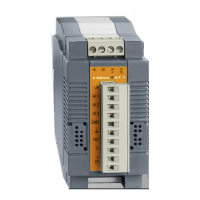e.bloxx A6-2CF
CONFIGURATION
38
HB_EBLOXX-A62CF_E_V19.doc
Gantner Instruments Test & Measurement GmbH
After changing some of these settings, the new settings have to be loaded into the corresponding e.bloxx A6-2CF, so
they can take effect. Therefore select the menu item
Send to Module
or
Send to Module as...
in the menu
File
or the
corresponding button ( ) in the icon bar.
5.4. Definition of Channels
Up to 16 channels (real plus virtual) can be defined for an e.bloxx A6-CF. They define how the signals at the in- and
outputs of the e.bloxx A6-2CF will be processed. The value of every channel can be read out via the fieldbus. The
channels are defined in the Variable Settings Table in the Configuration Software ICP 100. This table is displayed on the
register card "Variable Settings" in the Configuration Software ICP 100.
Picture 5.2
. - Example for Variable Settings Table
Here all 16 possible channels will be listed. To define a new channel just click on a free line in the table or to change the
type of channel click on the first column
Type
in the corresponding line. In both cases a dialog box will be opened where
the type of the new channel has to be selected. There are 8 different types of channels:
- Alarm: An Alarm Channel can be used to monitor another channel and to generate an alarm message if
one of up to 4 definable thresholds are exceeded. The alarm messages can be read via bus.
- Analog Input: Used to measure analog sensor signals. In the columns
Type
and
Sensor
it is possible to select
the measurement function (see chapter 4).
- Analog Output: Used to output the value (cross, net, unbalanced, peak-value, etc.) as analog voltage signal.
- Arithmetic: With this channel it is possible to perform calculations with the actual values of other channels
and with constant values. The results of the calculations are assigned to the arithmetic channel
and so arithmetic channels can also be used by other arithmetic channels for calculations. The
arithmetic channel operates with a rate of max. 1000/s.
- Digital Input: Used to record digital status signals and to measure frequencies or counter.
- Digital Output: Used for digital status signals or process-related signal output. In the column
Type of
Measurement
it is possible to select the measurement function (State or Process Out).
- Setpoint: The value of this channel can be set via bus. This way it is possible to set a value via bus which can be
used by an arithmetic channel for further processing, e.g. to set a factor for measurement by the user.

